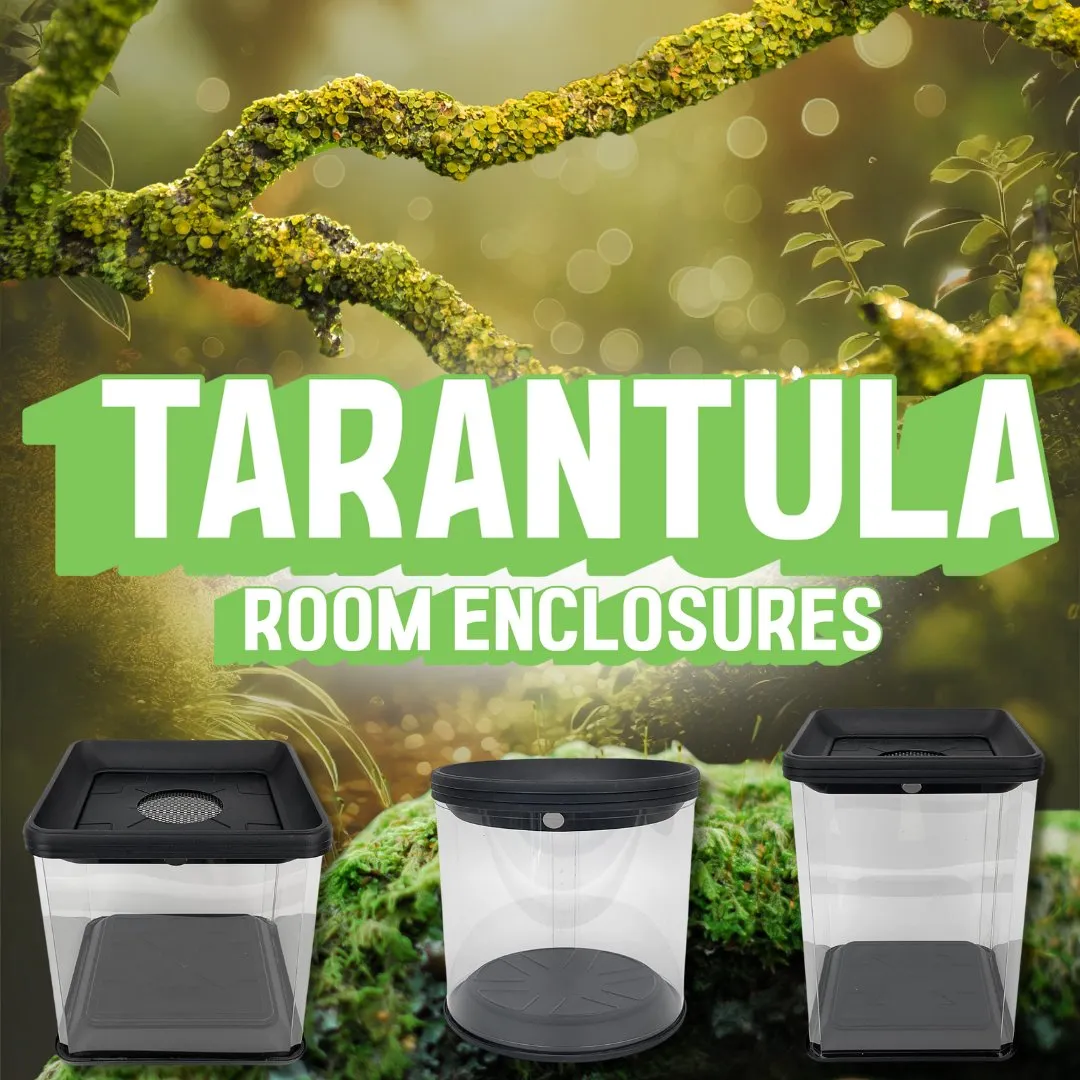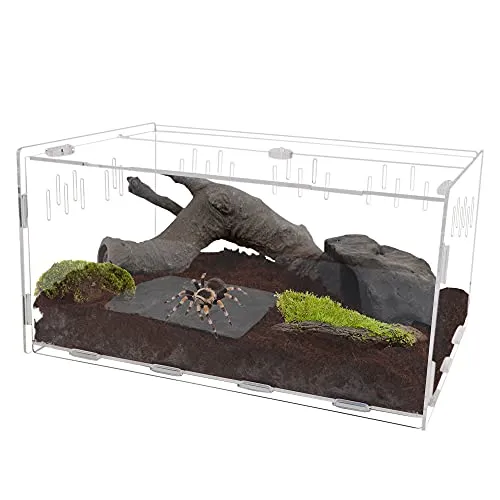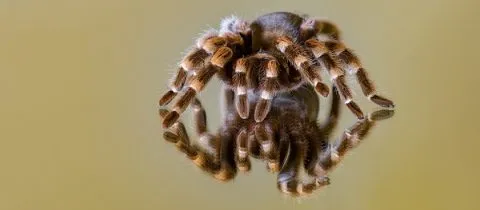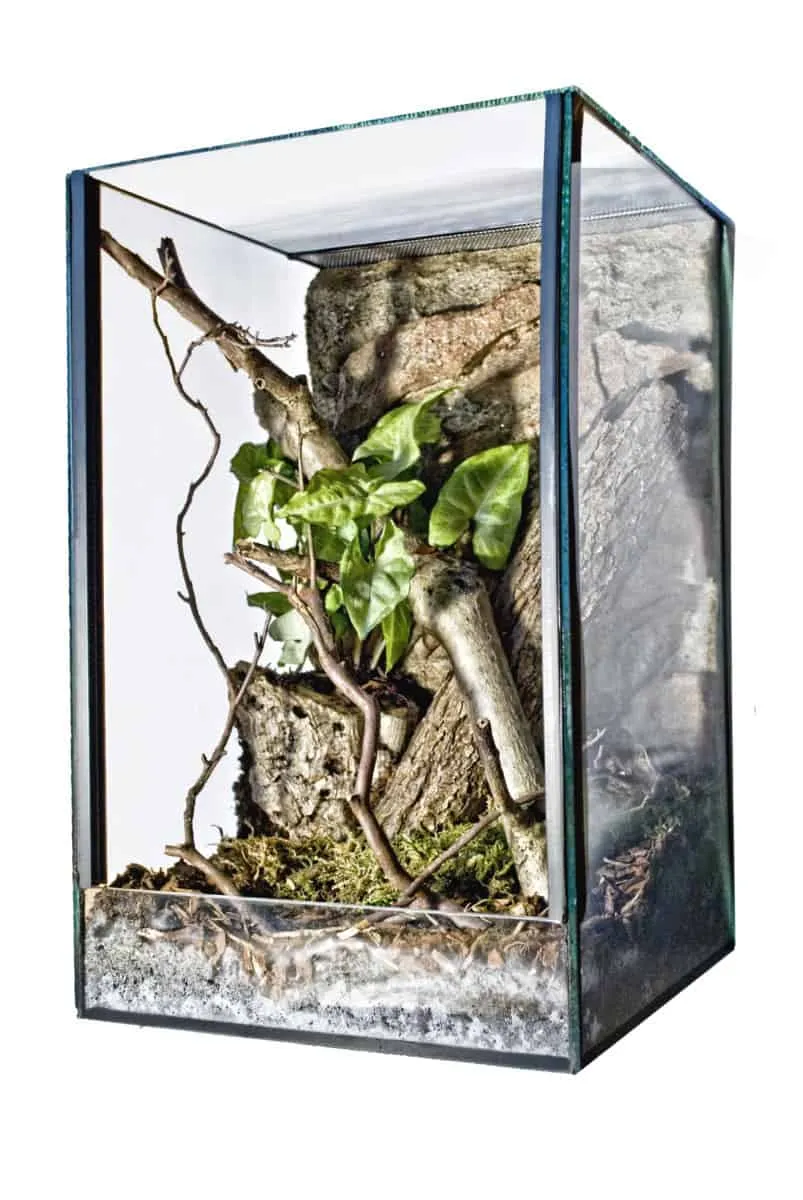Why Choose the Best Tarantula Enclosures
Choosing the best tarantula enclosures is a crucial decision for any spider owner, directly impacting the health, well-being, and longevity of your pet. A well-designed enclosure provides a safe, secure, and stimulating environment that mimics the tarantula’s natural habitat. Poor enclosure choices can lead to various problems, including stress, difficulty molting, and even premature death. The right enclosure facilitates proper temperature and humidity regulation, which are critical for a tarantula’s survival. Furthermore, the enclosure’s size and features will dictate how comfortably your tarantula lives, how actively it can hunt, and how easily you can observe and interact with it, making it a fundamental aspect of responsible tarantula ownership. Selecting the right enclosure shows that you are caring and devoted to the well-being of your pet, creating a long-lasting and enjoyable experience for both you and your tarantula.
Proper Ventilation Importance
Proper ventilation within a tarantula enclosure is absolutely vital to prevent mold and bacterial growth, and to regulate humidity levels effectively. Stagnant air can quickly lead to the buildup of harmful microbes, posing a serious health risk to your spider. Good ventilation ensures that excess moisture, which promotes fungal growth, is efficiently removed. This balance is essential because tarantulas require specific humidity levels to molt successfully and maintain their overall health. Well-ventilated enclosures also prevent the buildup of ammonia from waste products, which can irritate a tarantula’s respiratory system. When choosing or setting up an enclosure, make sure to consider features like mesh tops or strategically placed air holes to promote adequate air circulation. The level of ventilation needed will often depend on the species and the environmental conditions, but consistently providing fresh air is a cornerstone of good tarantula care.
The Role of Substrate

The substrate is more than just the bottom layer of your tarantula’s enclosure it’s a crucial element of its habitat. It plays a key role in maintaining humidity levels, providing a surface for the tarantula to burrow or hide, and offering a natural environment that reduces stress. The appropriate substrate should be able to absorb moisture to help regulate humidity and should not be toxic or harbor any harmful organisms. Common substrate choices include coconut fiber, peat moss, and a mix of vermiculite and soil. These options not only assist in maintaining the right humidity levels but also allow the tarantula to express natural behaviors such as burrowing. Furthermore, a suitable substrate can absorb waste and make cleaning easier. The choice of substrate will depend on your tarantula species’ preferences and their natural habitat; research the species-specific requirements to provide the best possible environment for your spider.
Best Tarantula Enclosures [Top 5]
Finding the perfect enclosure can be challenging, so here’s a curated list of the top 5 best tarantula enclosures, each offering unique features to suit various needs. These enclosures are selected based on factors such as ventilation, ease of access, durability, and suitability for different tarantula species. From beginner-friendly setups to advanced terrariums, this selection aims to provide a variety of choices that cater to both novice and experienced tarantula keepers. The following reviews will delve into the specific features of each enclosure, comparing their pros and cons, and providing insights to help you make an informed decision for your spider. Remember to always prioritize the well-being of your tarantula when choosing an enclosure, considering its specific needs and your own preferences.
Enclosure 1 Detailed Review
Enclosure 1 is a top-rated choice, known for its durability and ease of use. This enclosure is typically constructed from high-quality acrylic or glass, providing excellent visibility and allowing you to observe your tarantula without obstruction. Its design often incorporates features like secure locking mechanisms to prevent escapes and pre-drilled ventilation holes that ensure adequate airflow. The clear construction enables easy monitoring of temperature and humidity levels, and it’s often designed with a removable top or front-opening door to make cleaning and maintenance simple. Because of its simple design, it is suitable for beginner tarantula keepers and ensures a safe and stable environment for your spider, making it a great all-around choice for various tarantula species.
Features of Enclosure 1

- Durable construction with high-quality materials
- Secure locking mechanisms to prevent escapes
- Pre-drilled ventilation holes for optimal airflow
- Clear design for easy observation
- Easy-to-clean removable top or front-opening door
Enclosure 2 Detailed Review
Enclosure 2 focuses on providing a naturalistic environment with a focus on aesthetics and habitat simulation. This type of enclosure usually features a terrarium-style design with integrated backgrounds and decor to mimic the tarantula’s natural habitat. It typically incorporates features such as a deep substrate layer to encourage burrowing, strategically placed ventilation, and built-in water dishes. The emphasis is on creating an engaging and enriching environment for the tarantula. The construction often includes glass or high-clarity acrylic to allow for clear viewing and may also include specialized lighting to promote the growth of live plants if you choose to incorporate them. Enclosure 2 is an excellent choice for those who wish to create a visually stunning and enriching home for their tarantula.
Features of Enclosure 2
- Terrarium-style design with a naturalistic look
- Deep substrate layer for burrowing
- Integrated backgrounds and decor
- Strategic ventilation
- Built-in water dish
Enclosure 3 Detailed Review

Enclosure 3 prioritizes functionality and ease of maintenance. This enclosure is specifically designed with practical features to make the care of tarantulas as simple as possible. Typically, it features a robust, often stackable, design that conserves space. It often features a front-opening door for easy access to the enclosure, simplifying feeding, watering, and cleaning. The enclosure also typically includes built-in features such as feeding ledges and pre-installed ventilation systems, ensuring the tarantula’s essential needs are easily managed. Made of durable materials such as clear plastic or glass, Enclosure 3 provides excellent visibility and is ideal for both beginners and experienced keepers seeking a hassle-free setup. Its straightforward design makes it easy to maintain a clean and healthy environment.
Features of Enclosure 3
- Functional design prioritizing ease of maintenance
- Stackable design to conserve space
- Front-opening door for easy access
- Built-in feeding ledges
- Pre-installed ventilation systems
Enclosure 4 Detailed Review
Enclosure 4 is designed with advanced features that cater to specific tarantula species or specialized care needs. This type of enclosure frequently incorporates sophisticated climate control capabilities, such as built-in heating pads or temperature regulators, to maintain precise temperature and humidity levels. It may also include a highly detailed design to mimic the natural habitats of particular species, with options for custom terrarium setups. The materials used are generally high-quality and durable, often with enhanced ventilation systems to provide optimal air circulation. This enclosure is a great choice for experienced keepers who want to provide the best possible living conditions for their tarantulas, especially those with specific environmental requirements.
Features of Enclosure 4

- Advanced features for species-specific needs
- Sophisticated climate control options
- Customizable terrarium setups
- High-quality and durable materials
- Enhanced ventilation systems
Enclosure 5 Detailed Review
Enclosure 5 emphasizes a balance of cost-effectiveness and essential features. This enclosure is often available at a more affordable price point, making it an excellent option for new tarantula owners or those on a budget. It typically provides the basic requirements for tarantula care, such as adequate ventilation, a secure lid, and a transparent design for easy viewing. Despite its affordability, it’s important to ensure that this type of enclosure is constructed from safe, non-toxic materials, and that it can maintain the necessary temperature and humidity levels. Enclosure 5 represents a smart choice for people looking for a functional and reliable enclosure without overspending. It is a practical option to get started with tarantula keeping.
Features of Enclosure 5
- Cost-effective price point
- Essential features for basic care
- Adequate ventilation and a secure lid
- Transparent design for easy viewing
- Made from safe, non-toxic materials
Size Considerations

The size of your tarantula enclosure is extremely important for the well-being of your pet. A too-small enclosure can restrict movement and lead to stress, while a too-large enclosure can make it difficult for the tarantula to find food, feel secure, and regulate its environment. As a general rule, the enclosure should be at least two to three times the tarantula’s leg span in width, providing enough room for movement and exploration. The height should also be considered, particularly for arboreal species that climb and need space to molt safely. When selecting an enclosure size, remember to account for the tarantula’s adult size; juvenile tarantulas will need to be moved to larger enclosures as they grow. Always prioritize the tarantula’s comfort and safety when determining the ideal size, keeping in mind that the enclosure is its home, and it needs to be a suitable size for a healthy life.
Material Choices
The materials used in tarantula enclosures play a crucial role in providing a safe and sustainable environment. Glass and acrylic are the most common materials because they provide excellent visibility and are relatively easy to clean. Acrylic is especially good because it is lightweight and resistant to breakage. Plastic enclosures are another option, often a more affordable choice, but ensure the plastic is non-toxic and designed for pet use. Ventilation is another key consideration; mesh tops or drilled holes must be appropriately sized to prevent escape while ensuring adequate airflow. The choice of material should also take into account the tarantula’s species and its potential to damage or escape the enclosure. Selecting materials that are durable, non-toxic, and easy to maintain is key for your tarantula’s health.
Essential Accessories
Essential accessories for tarantula enclosures can significantly improve the quality of life for your pet. A water dish is a must-have, ensuring your tarantula has a constant supply of fresh water. Substrate provides the essential foundation for the habitat, and the type you choose should match the tarantula species. Hides, such as cork bark or artificial caves, are crucial, providing a sense of security and a place to retreat. Decorative elements, such as artificial plants and branches, can help replicate the tarantula’s natural environment. For arboreal species, providing vertical climbing space is critical. Lastly, having a reliable thermometer and hygrometer is essential for monitoring the temperature and humidity levels, helping you maintain the proper environmental conditions. Careful selection of accessories contributes to your tarantula’s overall well-being.
Maintaining Your Tarantula Enclosure

Regular maintenance is vital for maintaining a healthy and hygienic environment for your tarantula. Spot cleaning should be done at least once a week, removing any uneaten food, molts, and waste. The frequency of deep cleans will vary depending on the species and size of the enclosure, but it’s recommended to replace the substrate every few months to prevent the buildup of harmful bacteria and molds. Always be sure to wear gloves when handling the enclosure and its contents to prevent contamination and to protect your hands. During cleaning, inspect the enclosure for any damage or wear and tear and make any necessary repairs or replacements. Maintaining a clean enclosure is not only critical for your tarantula’s health but also helps ensure a pleasant viewing experience.
Regularly monitoring and adjusting humidity and temperature levels is also part of routine maintenance, as these factors are crucial to the tarantula’s health. Using a thermometer and hygrometer, you can easily track environmental conditions and make changes as needed. Remember that a well-maintained enclosure directly impacts your tarantula’s health and longevity.
